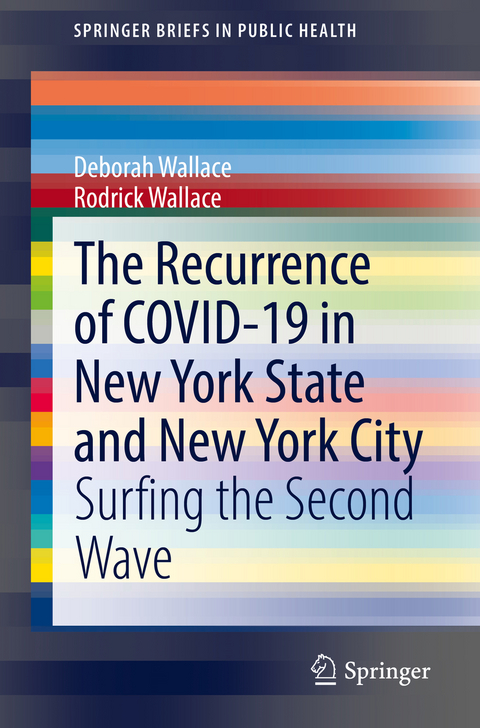
The Recurrence of COVID-19 in New York State and New York City
Springer International Publishing (Verlag)
978-3-030-88618-9 (ISBN)
Rural NYS counties differed significantly from urban ones socioeconomically and in infection rates during the cresting period. Before the crest, no socioeconomic factor was associated with county infection rates; rather, the major associating factor was political and cultural: percent of the 2020 vote garnered by Trump. Rural counties voted heavily for Trump. This association disappeared post-crest by mid-January 2021. In NYC, the Bronx again behaved like a single high-incidence entity, unlike the other three boroughs that had patches of high and low infection incidence.
Among the topics covered:
- The Second COVID Wave Washes Over New York State
- The Second Wave Storm-Surges Across New York City
- Discussion of County Data from the Second Wave of COVID-19
- Parsing Meaning From the 152 ZIP Code Data
The Recurrence of COVID-19 in New York State and New York City is a valuableresource for social epidemiologists, public health researchers of health disparities, those in public service tasked with addressing these problems, and infectious disease scientists who focus on spread in human populations of new zoonotic diseases. The brief also will find readership among students in these fields, civil rights scholars, science writers, medical anthropologists and sociologists, medical and public health historians, public health economists, and public policy scientists.
lt;b>Deborah Wallace, PhD, received her PhD in symbiosis ecology from Columbia University in New York City in 1971. In 1972, she became an environmental studies manager at Consolidated Edison Co. and participated in pioneering environmental impact assessment. She became a manager of biological and public health studies at New York State Power Authority in 1974 and remained there until early 1982. In 1980 she completed a MiniResidency in epidemiology at Mount Sinai Medical Center. In the mid-1970s, she also founded Public Interest Scientific Consulting Service, which produced impact assessments of massive cuts in fire service in New York City. She also probed the health threats that plastics in fires posed to firefighters and became an expert witness in litigation for plaintiffs in large fires fueled by plastics. From 1985 to 1991, she worked for Barry Commoner at the Center for the Biology of Natural Systems at Queens College. From 1991 to 2010, she tested consumer products and services for their environmental and health impacts at Consumers Union. She retired in 2010 but continues data analysis, research, and scientific publications. Her first paper was published in 1975, and her last publication, a book, in 2021.
Rodrick Wallace, PhD, is a research scientist in the Division of Epidemiology at the New York State Psychiatric Institute, affiliated with Columbia University's Department of Psychiatry in New York City. He has an undergraduate degree in mathematics and a PhD in physics from Columbia University, and completed postdoctoral training in the epidemiology of mental disorders at Rutgers University in New Brunswick, New Jersey. He worked as a public interest lobbyist, including two decades conducting empirical studies of fire service deployment, and subsequently received an Investigator Award in Health Policy Research from the Robert Wood Johnson Foundation. In addition to material on public health and public policy, he has published peer reviewed studies modeling evolutionary process and heterodox economics, as well as many quantitative analyses of institutional and machine cognition. He publishes in the military science literature, and in 2019 received one of the U.K. MoD RUSI Trench Gascoigne Essay Awards.
Chapter 1. The Sixty-Two Counties of New York State.- Chapter 2. The Second COVID Wave Washes over New York State.- Chapter 3. Socioeconomic/Demographic Context of the Big Apple's Four Main Boroughs.- Chapter 4. The Second Wave Storm-Surges Across New York City.- Chapter 5. Discussion of County Data from the Second Wave of COVID-19.- Chapter 6. Parsing Meaning from the 152 ZIP Code Data.- Chapter 7. What Is to Be Done?.
| Erscheinungsdatum | 19.12.2021 |
|---|---|
| Reihe/Serie | SpringerBriefs in Public Health |
| Zusatzinfo | XI, 92 p. 6 illus. |
| Verlagsort | Cham |
| Sprache | englisch |
| Maße | 155 x 235 mm |
| Gewicht | 171 g |
| Themenwelt | Studium ► Querschnittsbereiche ► Prävention / Gesundheitsförderung |
| Schlagworte | communities, foundations of pandemic response planning • COVID-19 in NYC • COVID-19 in NYC boroughs • COVID-19 in NYS • COVID-19 pandemic in cities • COVID in rural and urban NYS counties • COVID spread pattern • COVID testing inequalities in New York City • cross-border COVID spread • high COVID infection rates in Brooklyn and Queens • President Trump vote and COVID-19 • second wave of COVID-19 • socioeconomic factors and COVID infection in NYC • The Bronx as a unified COVID infection geography • worksites, foundations of pandemic response planning |
| ISBN-10 | 3-030-88618-2 / 3030886182 |
| ISBN-13 | 978-3-030-88618-9 / 9783030886189 |
| Zustand | Neuware |
| Haben Sie eine Frage zum Produkt? |
aus dem Bereich


